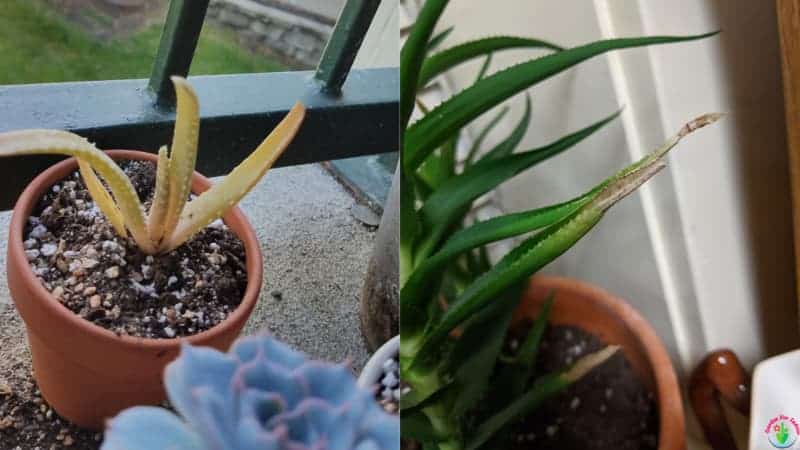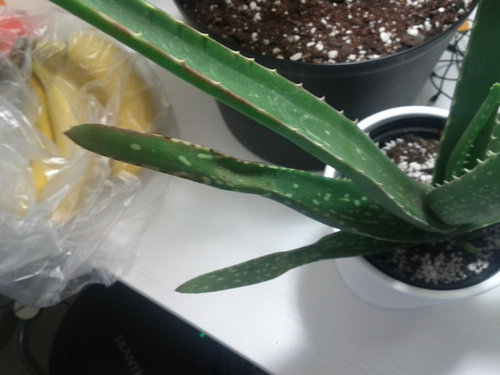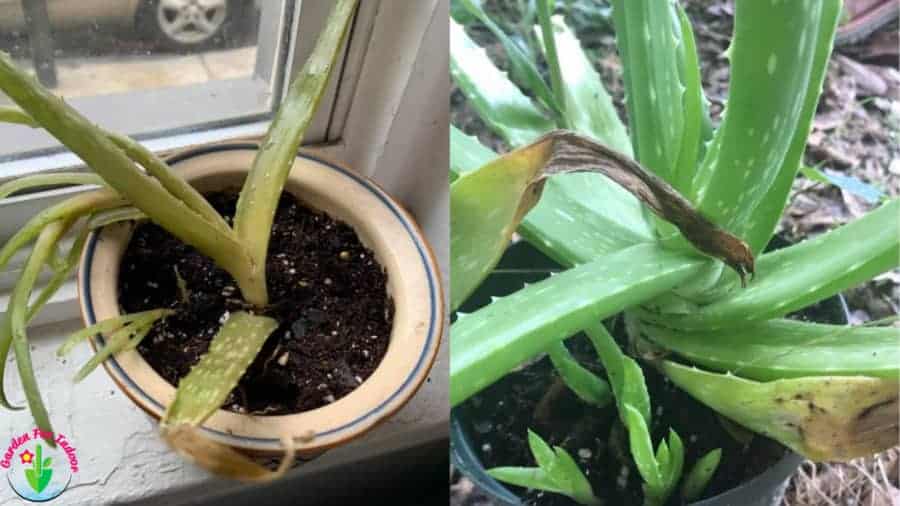The leaves of an overwatered aloe plant turn brown and yellow and have a mushy, soft texture; in contrast, the leaves of an underwatered aloe plant become thinner and shrink in size before becoming brown.
Aloe plants are succulents, and because they store moisture in their leaves, they become smaller when the plant is submerged.
Aloe plants, on the other hand, have evolved to withstand drought and do considerably better with underwatering than with overwatering.
Continue reading to find out how to salvage an underwatered aloe plant and the difference between the two.
Table of Contents
How to Tell If the Aloe Plant is Overwatered
Overwatering of an aloe plant causes the leaves to become yellow or brown, become soft and mushy, and appear to be drooping. The roots decay and die back, appearing brown and emitting a foul odor.
Native to the Arabian Peninsula, aloe plants thrive in poorly drained, rocky soils with infrequent rainfall.
Aloe plants are therefore exceptionally adept at withstanding drought conditions, making them extremely vulnerable to overwatering and slow-draining soils, which typically results in root rot or mushy, brown or yellow leaves.
Other factors, such sunburn, can also cause aloe plants to become brown. Why is my aloe going brown? (Read my article).
The most frequent error in aloe plant care is overwatering and planting aloes in soils with poor drainage.
Aloe plants flourish when they receive vigorous watering followed by a dry period of approximately two weeks, as this mimics the cycle of watering that they generally encounter in their native environment—a deluge of rain followed by a time of drought.
Aloe plants are able to survive in dry climates with well-draining soils because they absorb moisture from the potting soil after a thorough soak and store it in their leaves.
Aloe plants need the soil to be fully dry between watering sessions, thus you should normally water your aloe plant every two weeks (Read my article, how to water aloe vera for how often to water aloe vera at different times of the year).
Overwatering occurs when you water an aloe plant more frequently than once per week since it prevents the soil from having enough time to dry up.
To minimize the effects of overwatering, it is crucial to understand that the proper watering schedule must work in tandem with the right, well-draining potting soil.
Aloe plants do not thrive in regular potting soil because it retains moisture around the roots for an excessively long time after watering, leading to overwatering symptoms.
If you catch the issue early, before root rot can develop, an aloe plant with mushy, drooping leaves is a warning sign of overwatering but may not necessarily signal that the plant has acquired root rot.
How to Fix an Overwatered Aloe Plant
- Wait until the potting soil is completely dry in between waterings. Feel the dirt at the bottom of the pot via the drainage hole in the base to determine when to water your aloe plant once more. If there is still moisture present, wait a few days before watering. The ideal time to water is when the potting soil feels dry.
- Remove your aloe plant from the ground, then check the roots for signs of root rot. The roots should look strong and have a lighter color (note roots can be discolored brown with soil). With a sharp pair of pruners, remove any rotting roots that are dark, have a mushy texture, or smell terrible so that new, healthy roots can develop in their place. To stop the transmission of fungus pathogens to healthy roots, sterilize the pruners with a towel dipped in a disinfectant. Remove all rotten roots with a scissors until only healthy, solid roots are left.
- Use a good set of pruners to remove any yellowing or browning leaves. You can occasionally gently peel the leaves back. By removing these discolored leaves, the rot won’t spread to other parts of the aloe plant.
- If the dirt is draining slowly, repot your aloe in soil made for succulents and cacti. To mimic the native soil conditions of the aloe plant, special soil for succulent and cacti plants has been developed. The easiest strategy to reduce the effects of overwatering is to enable water to drain effectively (see my post on the best potting soil for aloe vera).
- Before repotting, clean out the pot, or better yet, repot the aloe into a terracotta or clay pot. Since the pot may have fungi that are spread by moist soil, disinfect it with a disinfectant. The best containers for aloe plants are made of clay or terracotta because they are porous and allow the soil to dry out more evenly between waterings, reducing the risk of root rot (read my article, choosing the best pots for aloe vera).
- While the aloe plant heals, place it in strong indirect light for two weeks. Aloe plants can withstand direct sunshine, but a sick plant may be further stressed by the intense heat and high temperatures, so place the aloe in a sunny area.
Aloe plants can recover from excessive watering, but if the root rot is too severe, the only solution is to grow more aloe from any healthy leaves that are still there.
The only option to save the overwatered plant may be to reproduce aloe plants, which are rather simple to do. Check out this instructive YouTube video to learn how to grow aloe plants from leaves.
How to Tell Whether an Aloe Plant is Underwatered
When an aloe plant is submerged in water, the plant’s size is reduced, and the leaves flatten down and curl inward as the aloe draws on its internal moisture stores. If the leaves are heavily submerged, they will also turn brown.
Native to dry, arid locations with well-draining soil and infrequent rainfall, aloe plants thrive there.
Although aloe plants don’t require as much watering as the majority of houseplants, they should constantly be given a good soak.
The recommendation that “succulents and aloe plants do not need much water” is sometimes misunderstood to mean that they should only receive minimal irrigation.
If you water the soil too lightly, the water will only reach the aloe’s roots on the surface and not penetrate the potting soil to where it is needed.
Before letting the earth dry out, aloes need the soil to be evenly hydrated so that the roots may access the moisture they need. After that, the moisture is held in the leaves, which is why an aloe plant in good condition has leaves that feel and appear full.
The leaves of an aloe plant that has been submerged get thinner as it draws on its reservoir of moisture.
Fortunately, the aloe uses this capacity for water storage as part of its survival strategy to deal with the hot and dry conditions of its natural habitat. As a result, aloe typically adapts well to being submerged and recovers pretty rapidly.
It is crucial to keep in mind that if the pot is very small, the aloe’s soil may dry out much more quickly, which may result in underwatering symptoms. The soil can dry out too quickly for the aloe’s roots to absorb adequate moisture, which can result in an underwatered aloe, as can extreme temperatures, intense sunlight, and indoor heat.
temperature, vigorous growth, and pot size
How to Save an Underwatered Aloe Plant
- For about 10 minutes, submerge the aloe in a bowl of water, making sure the dirt and root ball are covered. This method allows the potting media to absorb effectively and reach the roots, making it the ideal technique to water an aloe plant that has been badly submerged. A heavily underwatered aloe poses a risk of the potting baking hard, which can make the soil hydrophobic (rejects water), which causes the water to drip off the soil’s surface and out the drainage hole in the base without reaching the roots.
- After giving the aloe plant a good soak in a bowl, remove it and drain any saucers or trays that may have accumulated extra water. As a result of the roots being able to pull up moisture to store in the leaves, your aloe should immediately start to look better. To prevent overwatering, wait to water the aloe again until the potting soil seems dry.
- Always give aloe plants a good soak so that any extra water drips out the bottom of the pot. For the aloe’s roots to be able to absorb the moisture they need, the potting soil must be evenly moist.
To save an underwatered aloe plant, you must first determine how rapidly the soil dries up. The aloe plant’s maturity, the size of the pot, and the temperature of its surroundings can all affect how quickly the soil dries.
Give your aloe a good bath, then feel the soil at the bottom of the container to determine how many days it takes for it to feel dry. This will help you determine the best watering schedule for your aloe plant (and prevent it from being underwatered). The best time to water is when the soil feels dry at the bottom (check for moisture by feeling the soil through the drainage holes in the base).
Key Takeaways:
- Looking at the leaves is the easiest way to determine whether your aloe plant is being overwatered or underwatered. Aloe leaves that are overwatered turn brown and yellow and have a soft, mushy texture, but aloe leaves that are underwatered become thinner and smaller before turning brown.
- Replace the potting soil with a gritty, well-draining mix, remove any leaves that are going brown or yellow, and trim back any roots that are too long. Then, wait until the soil is totally dry before watering the aloe plant again.
- Place the aloe pot in a basin of water for 10 minutes, making sure the root ball is submerged, to revive an underwatered aloe plant. This will equally moisten the soil and help the roots to absorb the moisture they need to refill the moisture stores in the leaves.
FAQ
What does an overwatered aloe plant look like?
Overwatering of an aloe plant causes the leaves to become yellow or brown, become soft and mushy, and appear to be drooping. The roots decay and die back, appearing brown and emitting a foul odor. Native to the Arabian Peninsula, aloe plants thrive in poorly drained, rocky soils with infrequent rainfall.
How do I know if my aloe is Underwatered?
Looking at the leaves is the easiest way to determine whether your aloe plant is being overwatered or underwatered. Aloe leaves that are overwatered turn brown and yellow and have a soft, mushy texture, but aloe leaves that are underwatered become thinner and smaller before turning brown.
How can I tell if my aloe plant needs water?
Put your finger into the ground just past the second knuckle. The plant needs water if it is dry. Wait a few days if it’s still damp. Check the irrigation holes as well to see if the soil is overly wet and mushy.
How do you fix an overwatered aloe plant?
Replace the potting soil with a gritty, well-draining mix, remove any leaves that are going brown or yellow, and trim back any roots that are too long. Then, wait until the soil is totally dry before watering the aloe plant again.
How do I know if my aloe plant is overwatered?
If your aloe plant develops what are known as water-soaked areas on the leaves, which appear soggy and soft, you know it is being overwatered. The leaf nearly seems to become completely soaked with water before turning to mush.



